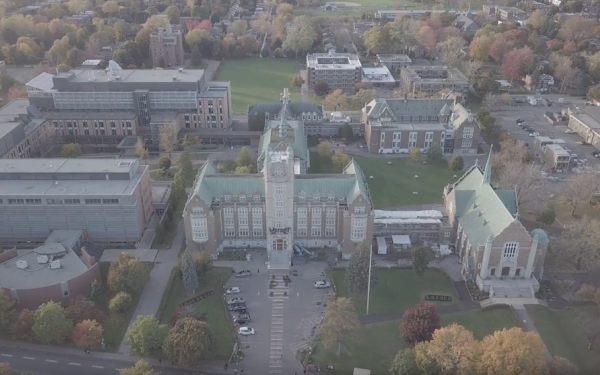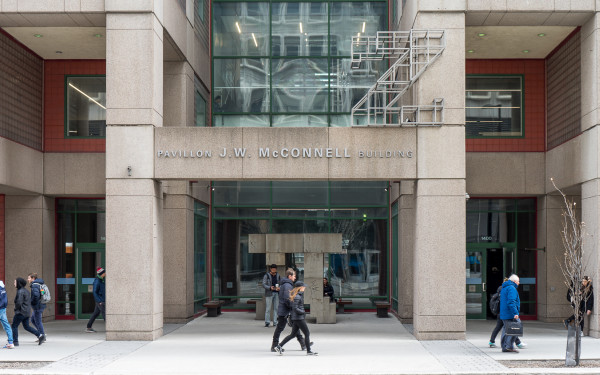Restructuring the Ivory Tower
How Online Courses and Student Space Are Rearranging the Future of Universities
Universities stand like pillars in our society.
While governments, borders and laws remain in flux, the institutions of higher learning are slow to change.
This hesitancy to alter traditions is what has led them to remain standing as physical representations of academia, but is also preventing them from fully engaging with the innovations driving our fluid society forward.
Concordia President Alan Shepard says that this quickly moving “Twitter age” goes against the traditional sensibilities of universities.
“Over the centuries certain academic values have been transmitted; one of which is great cautiousness in the face of change, and skepticism about change, […] but the 21st-century world is so dynamic,” said Shepard.
“I think the struggle of universities will be to keep up with the pace of change that the rest of society is engaged in. I think that’s going to be hard for our sector because I think our academic instincts are to go much more slowly and deliberately.”
And while our deeply rooted educational institutions struggle through the painful growth phase of figuring out how to adapt, the idea of what teaching is changing. Universities are now being tested as they never have been before. Shepard, however, thinks he’s up to the task.
Digital Learning
The explosion of ideas like video games as teachers and massive open online courses (or, simply, MOOCs), are changing the ways people are thinking about learning and access to learning.
MOOCs are offering free academic courses online, general based on university curriculums, taught lecture style. The model allows for unlimited enrolment across the globe.
The top players in the MOOC model—edX, Coursera and Udacity—are offering video lectures, quizzes and discussion boards that have attracted over a million students so far.
Coursera, the biggest of the three, offers 197 courses in 18 subjects and has enrolled 1.7 million users, thanks in part to its curriculum, which comes from 33 of the biggest American universities including Princeton, Brown, Columbia and Duke.
“It’s really, really early days to figure out what’s going to happen with the massive open online courses, […] but something’s going to happen,” said Shepard. “The model is very unstable.
“[Online courses are] not a lesser form of learning. They’re different.”
These non-credit courses might not stay that way for long, however. Antioch University in Los Angeles will begin offering academic credit next semester for certain Coursera courses—for a fee, of course.
AULA’s website says, “Each Coursera course will be facilitated by an AULA faculty member who will also be enrolled in the course, thereby enabling both frequent interaction between students and instructor and augmentation of the course through supplemental exercises and projects focused on expanding the learning experience.”
Antioch is the first to turn outsourced MOOCs into profit and supplement the online experience with their own teachers.
Currently, students enrolled in MOOCs are encouraged to form study groups within their areas—but can this model replace the collaboration that is facilitated in the university setting?
Spaces
Collaborative and innovative spaces for learning are one advantage that physical universities still have over e-learning.
“What students are looking for today, frequently, is group space—places where you’re working on a project with a colleague,” said Shepard. “You can only be at the Tim Horton’s so long. You need a good table; you need good light; you need to be able to plug in your laptop.”
Universities provide that integral space that allows for not only planned group collaboration but also for the happenstance encounters that seem to drive innovation.
Ryerson University, where Shepard was provost before coming to Concordia, has just broken ground on a new 10-floor Student Learning Centre that promises to offer students the space that they crave.
“Each floor’s got its own kind of distinctive mission,” said Shepard. “‘The Beach’ is going to have very casual flopping-around space, and as you go further up in the building, it gets quieter and kind of more organized—study space.”
Shepard’s office was totally engaged with making the decisions about who and what would occupy the new centre, with a focus on the needs and wants of students.
“One of the things I’m really proud of about that building is that it’s really for students. We didn’t fill it up with space for offices. […] As you go floor by floor, the character of the spaces available to students is different.”
The recent $4.5 million acquisition of the fifth and sixth floors of the Faubourg Building that will be used to expand Concordia’s Webster Library is still in the infancy stages of planning; Shepard said the expansion is “kind of an interim measure.”
“There isn’t even a lead on the project yet. It’s still in the conceptual stages,” said Concordia spokesperson Chris Mota.
Many are hopeful Shepard’s careful consideration of student needs at Ryerson will translate into the same sort of influence at this urban campus.
Currently, the plan for the two floors of the Faubourg involves shifting some of the academic units that are being housed in the J.W. McConnell Building to make way for more downtown student study space—space that Shepard says he hopes will develop from a slew of student feedback.
“What I favour is a model where you ask students what they think they want a need,” said Shepard. “When I was at Ryerson, and at [the University of] Guelph, too, when we were thinking about buying furniture for public spaces, we actually brought out some samples and we asked people to vote.”
Library expansion will not, however, solve ConU’s crunch for space, said Shepard.
“What would be awesome to do is a whole new building dedicated to student learning and student study,” said Shepard. “[But] that’s an expensive proposition.”
The acquisition of new buildings is a tricky business, one that involves working within the strict codes of the city—and that means making space for retail. Shepard says that retail outlets will be chosen in harmony with the values of the university and will also mean additional revenue coming from the leased out space.
“If you’re putting academic buildings along major arteries like de Maisonneuve Blvd. or Guy St., frequently city code now requires you to include retail at ground level,” said Shepard. “What they don’t want is you walking along […] and there’s this building that’s kind of like granite and stone and there’s doors going in but otherwise there’s no engagement.”
Curriculum
Universities also seem to grip their curriculums with white knuckles, making the process of adapting to new innovations that much more difficult.
Shepard emphasizes the need for constant reform to keep pace with the current generation of blogophiles.
This includes the integration of what he refers to as “blended classes”—ones that strike a balance between online and face-to-face learning. There is not one methodology that will create the perfect solution, he says, and the implementation of technology in the classroom is still not a perfect science. It may never be.
“Curriculum is like a living, breathing thing. You can’t just make a curriculum and then wait 20 years,” said Shepard. “And people don’t.”
Gesturing to a fat three-ring binder packed with papers filled with curriculum changes, he says that is a concrete sign of changes that are being made to make programs for effective for the learner.
In 2010, Ryerson made significant advancements in the idea of how academic credit is earned with the creation of its Digital Media Zone.
In the 16,500-square-foot space, entrepreneurs work to develop businesses, hook up with mentors and create networks. The DMZ model pushes students to create their own jobs instead of struggling to fit into jobs that have already been created.
Summit
Something that also has the potential to foster change is the proposed summit on higher education that newly elected Quebec Premier Pauline Marois promised.
Quebec’s higher education system has been suffering from one of the lowest participation rates in the country, underfunding or—as many student groups like the Fédération étudiante universitaire du Québec argue—mismanagement of funding, and strained communication lines between the Ministry of Education and universities themselves.
Shepard says that when the length of the summit is announced, it will give a lot of clues about what can be accomplished.
“I would say that what we’re looking for from any government ministry that is our funder is a clarity around their goals, so we can understand how we can fit in with those goals,” said Shepard. “[We’re looking for] fair play among all universities and adequate funding to provide the quality of education that Quebec needs and wants, and that our students need and want.”
While these centuries-old ideals push against the innovations of this age, Shepard has unwavering belief in the institutions of higher education.
“I have a lot of faith in universities,” said Shepard. “We’ve survived everything: civil wars, floods, disasters, despots, corruption. […] I think we will adapt, but there might be some discomfort as we make those adaptations.”

01_700_1054_90.jpg)
_600_832_s.png)

1_600_375_90_s_c1.jpg)
_600_375_90_s_c1.jpg)

